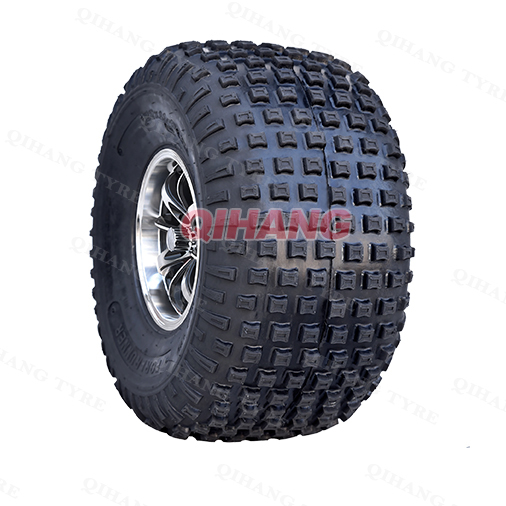The structural characteristics of industrial tires are the core foundation for their safety performance and functional realization, directly affecting load-bearing capacity, durability, risk resistance, and operational efficiency. The following analysis examines these characteristics from three aspects: design principles, key structural elements, and actual impacts:
1. The Fundamental Relationship Between Structural Characteristics and Safety Performance
Industrial tires operate under high loads, high impacts, and complex conditions. Their structural characteristics ensure safety through the following mechanisms:
Mechanical Balance Design: Parameters such as the number of cord layers and the angle of the steel wire arrangement in the tire carcass must precisely match the load requirements. For example, in all-steel radial tires, the cords form a 90° angle with the tread centerline, which can disperse vertical loads and reduce lateral deformation, preventing tire blowouts or rollovers due to structural imbalance.
Energy Dissipation Mechanism: The elastic modulus of the sidewall rubber and the flexibility of the tread pattern together constitute a cushioning system. Taking mining dump truck tires as an example, their sidewall thickness can be up to twice that of ordinary tires, absorbing impact energy through elastic deformation and reducing the risk of fatigue damage to the wheel hub and suspension system.
Redundant Protection Design: Multi-layered protective structures (such as belt layers and bead wires) form a "tiered barrier." When the tread is punctured, the belt wires can temporarily maintain the tire's profile, ensuring the vehicle travels to a repair point at a safe speed.
2. Functional Analysis of Key Structural Elements
Material Selection: The steel cords in all-steel skeleton tires have a tensile strength exceeding 2000MPa, five times that of ordinary nylon cords, ensuring structural integrity even under a 200-ton load.
Bias-ply tires: The cord layers are arranged in a cross pattern, suitable for low-speed, heavy-load scenarios (such as underground mining tires), but prone to heat generation due to interlayer friction;
Radial tires: The cords are arranged radially, reducing rolling resistance by 15%-20%, suitable for high-speed continuous operations (such as container handling vehicles in ports).
Tread Structure: "Intelligent Tentacles" for Complex Terrain
Block Pattern: Provides high traction, but wears 30% faster than grooved patterns, suitable for low-speed equipment such as bulldozers;
Mixed Pattern: Combines block and groove designs, balancing traction and wear resistance, the mainstream solution for loader tires.
Rubber Compound: Mining tires contain over 30% carbon black in the tread, achieving a Shore hardness of over 70, improving cut resistance by 50%; winter construction tires contain silicon-based filler, maintaining elasticity even at -30℃, preventing brittle fracture.
Sidewall Thickness: Construction machinery tires have a sidewall thickness ≥25mm, 1.5 times that of ordinary tires, capable of withstanding impacts from gravel up to 20mm in diameter.
Tire Bead Structure: The hexagonal steel cord bead has ≥6 layers of fabric covering to ensure a tight fit between the tire and the rim, preventing it from coming off the bead during high-pressure inflation. For special scenarios (such as desert tires), a tubeless + low-pressure design is used, and the bead must pass a -0.6MPa negative pressure test to prevent air leakage caused by sand intrusion.
3. Impact of Structural Characteristics on Application Scenarios
Case Study: A certain model of loader tire, operating in a quarry, needs to withstand a single 10-ton rockfall impact. Its tire body uses a "sandwich" structure (two layers of steel cord fabric + one layer of aramid fiber), achieving an impact energy absorption rate of 65%, a 20% improvement over traditional structures.
Data Support: Tires with Kevlar fiber protective layers added to the sidewalls reduce puncture failure rate by 40%; increasing tread depth from 25mm to 30mm extends service life by 1.8 times, but increases rolling resistance by 8%, requiring optimization of tire body stiffness to balance energy consumption.
Mining Scenarios: The Dual Challenges of Heavy Loads and Complex Terrain
Structural Optimization: Nano-sized silica is added to the tread compound, reducing brittleness while maintaining hardness, improving tear resistance by 35%; a "smooth tread carcass + external tread blocks" design is adopted, allowing for individual tread block replacement, reducing total tire replacement costs by 40%.
Safety Redundancy Design: The diameter of the bead wire is increased from 2.5mm to 3.2mm, raising the resistance to bead slippage pressure from 3.5MPa to 4.2MPa; a pressure balancing membrane is built into the sidewall, automatically adjusting internal air pressure during altitude changes to prevent structural damage caused by sudden pressure fluctuations.
Port Scenarios: Balancing Heat Dissipation and Wear Resistance under Frequent Start-Stop Operations
Key Technologies: The tread uses a "thermally conductive silicone + carbon fiber" composite layer, increasing thermal conductivity to 0.8W/(mK), three times that of ordinary rubber; the tire shoulder features spiral cooling grooves, increasing airflow velocity by 50% and reducing tire temperature by 15℃ at high speeds.
Structure-Performance Correlation: For every 5-degree increase in tread hardness, wear resistance improves by 12%, but rolling resistance increases by 6%. Optimizing tire carcass curvature through finite element analysis reduces stress concentration while maintaining load-bearing capacity, doubling fatigue life.
The structural design of industrial tires requires a dynamic balance between load capacity, durability, risk resistance, and economy. For example, mining tires sacrifice some rolling efficiency for safety through "ultra-thick carcass + high-hardness rubber," while port tires achieve a balance between efficiency and safety through "lightweight carcass + intelligent heat dissipation." In the future, with the development of materials science and digital twin technology, the structural characteristics of industrial tires will further evolve towards "adaptive, self-diagnostic, and self-repairing" capabilities, providing more reliable protection for the safe operation of industrial equipment.


